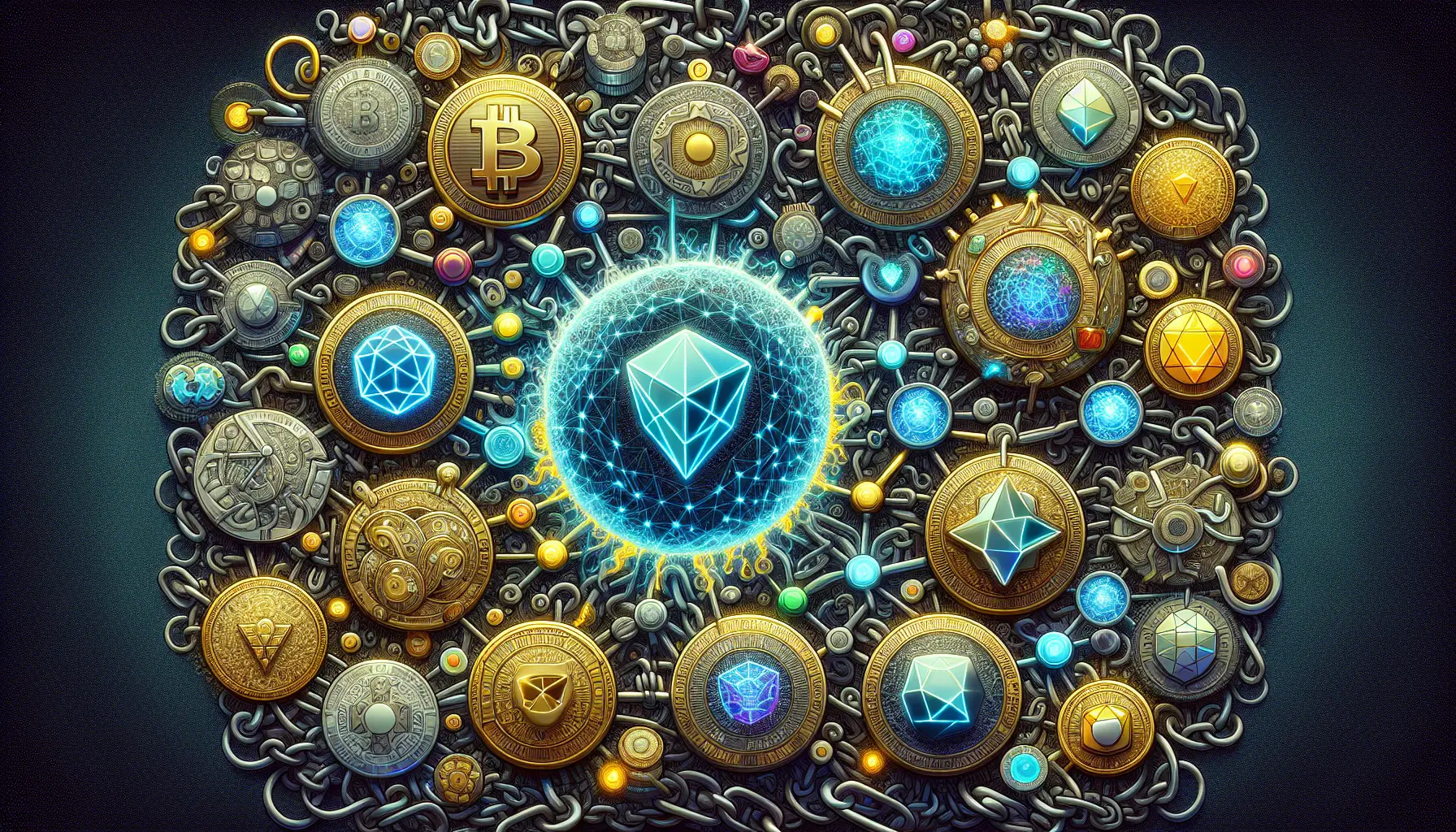Navigating the different types of cryptocurrency can be daunting. From Bitcoin to stablecoins, each type holds a unique place in the digital economy. This straightforward guide details the distinct categories and their roles, equipping you with the knowledge to explore the crypto landscape confidently.
Key Takeaways
- Cryptocurrencies, led by Bitcoin, have transformed financial transactions with their speed, security, and directness, while a growing range of altcoins and tokens are diversifying the digital currency landscape with specialized functions and use cases.
- Stablecoins such as Tether (USDT) and USD Coin (USDC) are crucial for mitigating volatility in the crypto market by maintaining their value equivalent to fiat currencies through asset backing and algorithmic controls.
- Blockchain technology underpins the evolution of digital currencies and DeFi, with platforms like Ethereum facilitating smart contracts and dApps. In contrast, CBDCs and globally focused digital currencies aim to improve payment efficiency and security.
Comprehensive table that highlights various types of cryptocurrencies, their purposes, and characteristics:
| Type of Cryptocurrency | Description | Examples | Key Characteristics |
|---|---|---|---|
| Coins | Independent cryptocurrencies with their blockchains. | Bitcoin, Ethereum, Litecoin | Used for a wide range of transactions; can be mined (Proof of Work). |
| Tokens | Digital assets built on top of other blockchains, representing various assets or utilities. | BAT, Tether | It is not minable; it is used for dApps and ICOs and can represent utilities or securities. |
| Stablecoins | Cryptocurrencies pegged to stable assets like fiat currencies to minimize price volatility. | USDT, USDC, BUSD | Aimed at providing stability, backed by reserve assets. |
| Altcoins | Alternative cryptocurrencies to Bitcoin, with varying degrees of differences from Bitcoin’s model. | NEO, Cardano | Different consensus mechanisms like Proof of Stake may be used. |
| DeFi Tokens | Tokens that facilitate decentralized finance services on blockchain networks. | UNI (Uniswap) | Used in decentralized lending, trading, and other financial services. |
| Exchange Tokens | Issued by cryptocurrency exchanges to offer user benefits and raise funds. | BNB (Binance Coin) | Offer trading fee discounts, voting rights, and other exchange-specific perks. |
| Meme Tokens | Cryptocurrencies that originated from internet memes or have a humorous or viral nature. | Dogecoin, Shiba Inu | Often community-driven and highly volatile. |
| Governance Tokens | Allow holders to vote on decisions that influence the direction of a project. | COMP (Compound), AXS (Axie Infinity) | Holders can participate in governance decisions that are often related to DeFi projects. |
| GameFi Tokens | They were used within blockchain-based games, often allowing players to earn financial rewards. | AXS (Axie Infinity) | Support a play-to-earn model, which can be used for in-game purchases and voting. |
| Wrapped Tokens | Represent other cryptocurrencies on a different blockchain to enable interoperability. | Wrapped Bitcoin (WBTC) | Enable using one blockchain’s assets on another, e.g., Bitcoin on Ethereum. |
This table encapsulates the diverse landscape of the cryptocurrency world, from traditional coins like Bitcoin and Ethereum to innovative concepts like DeFi and GameFi tokens, showcasing their various uses and mechanisms. Each category has specific applications and implications for investors and users, contributing uniquely to the evolving digital economy.
Exploring the Cryptocurrency Landscape

Technological advancements have greatly transformed life in the digital age, and the financial sector is no exception. With the advent of digital currencies, a new landscape of financial transactions, including digital money, has been unveiled.
At its core are cryptocurrencies, a class of digital currencies that secure transactions using cryptography on a network. They are known for their speed, cost-efficiency, and directness, but their irreversible nature necessitates precision to validate transactions and avoid mistakes or fraud. In this context, digital representation plays a crucial role in ensuring the accuracy and security of these transactions.
Given the potential investment risks and ongoing security and regulatory recognition challenges, a solid understanding of the crypto ecosystem becomes necessary. With over 10,000 cryptocurrencies available as of 2022, the market’s exponential growth is undeniable.
The sheer number of cryptocurrencies might seem overwhelming, but understanding their differences and applications can empower individuals and organizations to navigate this new frontier of digital finance.
The Original Crypto: Bitcoin

In the vast sea of digital currencies, one stands out as the pioneer – Bitcoin, the original cryptocurrency. Satoshi Nakamoto proposed Bitcoin as a decentralized digital currency. It emerged as a response to the financial crisis of 2007-2008. It aimed to bypass traditional financial institutions, introducing a revolutionary technology – blockchain- a public ledger for peer-to-peer transactions without needing third-party financial intermediaries around.
Bitcoin’s scarcity and demand define its market value, making it a unique asset compared to traditional currencies. It is utilized for various transactions, allowing tangible and digital items to be purchased.
Over time, many shops and services have started accepting Bitcoin as payment.
Altcoins: Beyond Bitcoin

Bitcoin’s success opened the door for alternative coins, known as altcoins. These digital currencies, such as Ethereum and Litecoin, were designed to expand capabilities and offer various innovations beyond what Bitcoin originally proposed, illustrating the versatility and adaptability of decentralized cryptocurrency technology.
Unique features such as Ether’s uncapped supply, Monero’s use of cryptographic techniques for transaction anonymity, and Stellar’s non-reliance on mining for energy efficiency set certain altcoins apart from Bitcoin and each other.
The diversity in the creation and function of altcoins showcases their significance in the market, with Binance Coin playing a key role in transaction fee payment and Binance’s DEX.
Tokens: Specialized Crypto Assets

Amidst the myriad of cryptocurrencies, tokens hold a unique position. They are non-native digital assets operating on existing blockchain infrastructures, differing from coins with their blockchains. Tokens serve specific functions within blockchain projects, including utility, security, and non-fungible tokens (NFTs).
Utility tokens allow users to access services or functions in particular blockchain projects, while security tokens represent digital forms of traditional financial assets like stocks. On the other hand, NFTs are unique tokens that verify the ownership of digital assets.
Businesses have started to adopt NFTs native tokens to generate new revenue streams by selling digital products and assets, demonstrating the growing commercial use of specialized tokens.
The Role of Stablecoins in the Crypto Market

Stablecoins play a crucial role in the volatile ecosystem of the crypto market. They maintain value equivalent to fiat currencies, commodities, or other cryptocurrencies through asset backing and algorithmic controls. Examples like Tether (USDT) and USD Coin (USDC) are pegged to the US dollar, providing market stability through transparent funding and better auditing processes.
Traders often resort to stablecoins to swiftly convert their assets into a stable currency during high volatility periods. This practice aids market stabilization by offering a consistent exchange rate, eliminating the need for traditional banking.
Among the most popular stablecoins are USDT (Tether) and USDC (USD Coin), both tied to the US dollar and contributing to the crypto market’s lowering of price fluctuations inherent in other digital currencies.
How Tether and USD Coin Maintain Parity with Fiat Currency
Asset-backed stablecoins like Tether and USD Coin maintain their value by being collateralized with real-world assets. These stablecoins are pegged to a specific amount of fiat or other valuable assets, which provides a foundation for their value and ensures it is tied to the actual worth of these assets.
Tether and USD Coin maintain their value at parity with fiat currency by being off-chain collateralized stablecoins. They are backed by real-world assets held by custodians, matching each circulating stablecoin with dollar-denominated assets.
This way, they offer a stable value amidst the often volatile crypto market.
Central Bank Digital Currencies: A New Frontier
Venturing into digital currencies introduces us to a new frontier – Central Bank Digital Currencies (CBDCs). These are digital counterparts of fiat currencies issued by central banks or monetary authorities, with the capacity to be used and stored in online wallets.
Notable CBDC initiatives are currently underway globally, with countries like the Bahamas, Jamaica, Nigeria, Brazil, China’s digital yuan, the euro area, India, and the United Kingdom at varying stages of development.
This new breed of digital currencies could improve payment system efficiency, enhance anti-money laundering efforts, and provide reliable and secure transaction methods, especially during low-interest periods or financial stress.
European Central Bank’s Digital Euro Initiative
One notable initiative in CBDCs is the European Central Bank’s exploration of creating a digital Euro. The objective is not to replace cash but to complement it, offering citizens a safe form of money in the fast-changing digital world.
To ensure a robust and secure digital euro, the ECB is focusing on the following aspects:
- Privacy in electronic payments while complying with anti-money laundering regulations
- Offline usability, allowing transactions without an internet connection
- Designing the interface to be widely accessible and user-friendly
- Implementing crucial security features to combat fraud and counterfeiting risks
Decentralized Finance (DeFi) Revolution
A new revolution is unfolding in the financial sphere – the Decentralized Finance (DeFi) revolution. Defi is transforming the financial sector by:
- Eliminating the need for traditional banking intermediaries
- Leveraging blockchain technology
- Disrupting conventional bank-based lending
- Allowing loans to be managed via blockchain-based smart contracts
One example of a DeFi lending protocol is Aave’s overcollateralized loan system.
The progressive rise of DeFi is catching the attention of institutional investors, signaling a potential integration of DeFi in regulated financial products.
The growth trajectory of blockchain technology, particularly within the DeFi sector, points to sustained development and integration in cryptocurrency markets and beyond.

The Evolution of Blockchain Platforms
The underlying technology driving these innovative assets becomes increasingly significant as we navigate the landscape of digital currencies. Blockchain platforms have grown beyond their initial association with cryptocurrencies and are now recognized for their potential across various industries due to their secure and transparent systems.
Interoperability and improved scalability are essential for the ongoing development and adoption of DeFi platforms, and platforms like Cardano are enhancing scalability while being more energy-efficient than Bitcoin.
However, it’s not just about transaction processing; these platforms also enable the creation of a wide range of decentralized applications, organizations, and assets.
Ethereum Network: More Than Just a Cryptocurrency
The Ethereum network exemplifies an Ethereum blockchain platform that transcends its role as just a cryptocurrency and even has the potential to support the creation of a cryptocurrency created by its blockchain. This platform supports:
- The development and deployment of smart contracts
- Decentralized applications (dApps)
- Without the potential for downtime, fraud, control, or third-party interference.
Ethereum’s ecosystem is expanding rapidly with the increasing popularity of Bitcoin Cash and its decentralized applications in various sectors, including:
- Finance
- Arts and collectibles
- Gaming
- Technology
Ethereum plans to implement sharding to address scalability concerns, which is expected to enhance the decentralized platform’s capability to handle more transactions.
Cryptocurrency and Innovation: What’s Next?
Cryptocurrency will likely feature increased regulatory oversight, enhanced security measures, and potential future integration with conventional financial systems.
Regulatory and legal actions are being taken against unregistered crypto offerings and fraud, indicating an increased focus on oversight and accountability within existing financial infrastructure and the industry.
The Investment Angle: Market Capitalization and Volatility
From an investor’s perspective, market capitalization is critical when assessing the relative size and investor interest in cryptocurrencies. The most recognized digital currencies, like Bitcoin, are known for their market cap. However, with so many cryptocurrencies, this digital gold rush is not without its challenges.
Bitcoin and other cryptocurrencies are known for their volatility. Prices are prone to rapid and significant changes influenced by factors like investors’ emotions and still being in the price discovery stage.
This volatility presents both lucrative opportunities and potential risks, making it crucial for investors to stay informed and exercise caution.
Navigating the Crypto Ecosystem: Wallets, Exchanges, and Security
Understanding the mechanics of crypto wallets and exchanges is key to fully benefiting from the crypto ecosystem. When creating a software crypto wallet, researching the wallet provider’s unique features and security protocols is crucial. To fund a software crypto wallet, users can deposit directly from a bank, exchange cryptocurrencies, or receive funds from another digital wallet via a wallet address or QR code.
On the other hand, hardware wallets enhance security by keeping private keys offline, which must be connected to a brokerage account or exchange for cryptocurrency transfers. When selecting a crypto wallet, consider the following factors:
- Security features
- Transaction fees
- Support for different cryptocurrencies
- Provider’s customer service
However, securing digital currencies remains a challenge. Risks in cryptocurrency storage include:
- Phishing
- Cyber attacks
- Losing login credentials or seed phrases
- Hardware wallet malfunctions
Therefore, understanding and implementing proper security measures are paramount in the crypto ecosystem.
The Social Phenomenon: Memecoins and Community-Driven Currencies
The rise of social media has given birth to a new category of cryptocurrencies known as meme coins. Memecoins such as Dogecoin and Shiba Inu have risen to popularity, carving out a niche within the cryptocurrency market. Social media influence, particularly from prominent figures like Elon Musk, can significantly affect the value of meme coins, demonstrating the power of community support.
Unlike Bitcoin, which has a fixed supply limit of 21 million coins, Dogecoin has an unlimited supply, illustrating a fundamental difference between meme coins and more established digital currencies.
This phenomenon is not just a testament to the power of social media but also highlights the dynamism and diversity of the crypto market.
Global Payments and Remittances: Cryptocurrency in Action
Global payments and remittances represent one of the most transformative applications of digital currencies. Cryptocurrencies like XRP and Bitcoin are increasingly used for international payments and remittances, offering faster and more cost-effective solutions than traditional methods.
The remittance industry is expected to exceed $107 billion by 2030, with cryptocurrencies increasing in addressing inefficiencies found in traditional methods.
Bitcoin and stablecoin-based platforms are emerging as significant players in the remittance market, offering faster and more stable money transfer options.
Smart Contract Platforms: The Backbone of Decentralized Applications
Exploring the technical facets of digital currencies introduces us to smart contracts. These are:
- Self-executing agreements
- The terms of the contract are directly written into lines of code
- Enabling more efficient processes by automating the execution
- Reducing the need for intermediaries
Smart contract platforms like Cardano and Solana enable the creation of decentralized applications with enhanced security, flexibility, and performance capabilities.
These platforms are not just facilitating transactions; they are reshaping the dynamics and decentralized nature of the digital economy by enabling a new breed of applications and services.
Overview
As we conclude our exploration into the world of digital currencies, it’s clear that the impact of cryptocurrencies extends far beyond being just a modern form of currency. From disrupting traditional banking systems to reshaping global payments and remittances, these digital assets are transforming the financial landscape. With their potential for inclusivity, efficiency, and innovation, cryptocurrencies are poised to play a significant role in the future of finance.
However, it’s important to remember that the journey into digital currencies is not without challenges. From understanding the complexities of the crypto ecosystem to navigating the volatility of the crypto market, it’s crucial to stay informed and exercise caution.
As the world of digital currencies continues to evolve, so should our understanding and approach.
Frequently Asked Questions
What is a cryptocurrency?
A cryptocurrency is a digital currency that secures transactions using cryptography on a network. It is a type of decentralized currency.
What is the difference between a token and a coin?
The main difference between a token and a coin is that coins have their blockchains, while tokens operate on existing, blockchain network infrastructures to serve specific functions within projects.
What are stablecoins?
Stablecoins are digital currencies that maintain value equivalent to fiat currencies, commodities, or other cryptocurrencies, providing market stability. They are designed to minimize price volatility.
What are meme coins?
Memecoins are a type of cryptocurrency that has become popular due to their social media presence and strong community backing.
What are smart contracts?
Smart contracts are self-executing agreements written in code, automating processes and transactions and reducing the need for intermediaries.
Disclaimer: The content on this site should not be considered investment advice. Investing is speculative. When investing, your capital is at risk.







